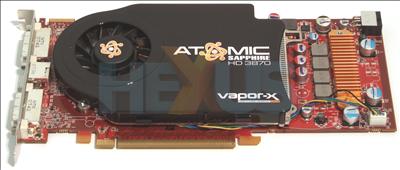Single-slot HD 3870
Sapphire's development team's brief was to design a cooler that would be better, in every way, than the one found on the reference Radeon HD 3870 512MiB card. It needed to be good, too, as the reference model was extremely quiet in 2D mode and, really, barely perceptible when under the yoke of full-on gaming. The problem with it, however, lay with the double-width cooler that precluded use in smaller chassis.
So how to design something that was better yet incorporated single-slot cooling? Sapphire's answer is the ATOMIC series, powered by vapour chamber technology (VCT), no less.
The cooler looks rather innocuous on first glance, similar to a slew of others found on the market, but, as always, the devil is in the details.
Thinking of it as a heatpipe and then some, the cooler's block contains a lower portion with extremely low air pressure. Inside, vaporisation wicks easily heat the sealed water up, thanks to the low pressure, as the GPU's heat is transferred through the base. The vapour is then transported until it hits the condensation wick and turns back into water. Then, the water is transported around the chamber, by capillary action, and back to the base, where the process begins again.
Sounds like a regular heatpipe-based approach, right? The main differences here are that the process can be undertaken in both directions, as opposed to the unidirectional approach of heatpipes. Further, according the Sapphire, there's less thermal resistance - due to lower copper use - and faster-than-heatpipe conductivity, too.
To reinforce this approach, Sapphire's ATOMIC HD 3870 uses, as you can see, a single-slot cooler which cools a GPU that runs at an overclocked core speed of 825MHz, compared to the default 777MHz. Sapphire's also used faster-than-default memory, too; the card is equipped with 512MiB of 2.4GHz-rated GDDR4, rather than the 2.2GHz stuff found on ye olde reference.
The UV-reactive ATOMIC VCT cooler kept the card humming along at 48C idle and 77C load. That's around 10C cooler than the dual-slot reference heatsink, we noted.
Being single-slot, it'll be easier to run four-way CrossFire on most AMD 790FX chipset-based motherboards, too.
The RV670 GPU is, on balance, a little faster than the outgoing R600 that debuted last May, but consumes around half the power, thanks to a bunch of improvements - DX10.1, PCIe 2.0, to name but two - a manufacturing process shrink to 55nm and some clever internal reworking of the core and how it interfaces with card-mounted memory.
The six-pin PCIe connector provides an additional 75W over and above the 75W provided by the x16 PCIe slot - and that'll be more than enough, even when pushing it further when overclocking.
Being a 3000-series card, both ports offer dual-link DVI - and HDMI through an adapter - connectivity as standard. Each port therefore also ferries audio through an on-GPU pass-through, as we saw in the lower-end HD 3000-series.
Nothing much to report on the back, folks.














